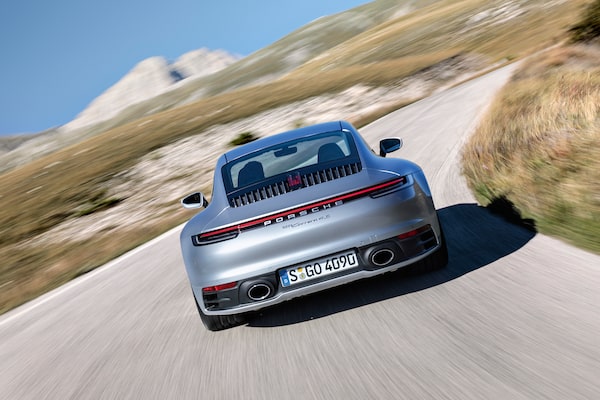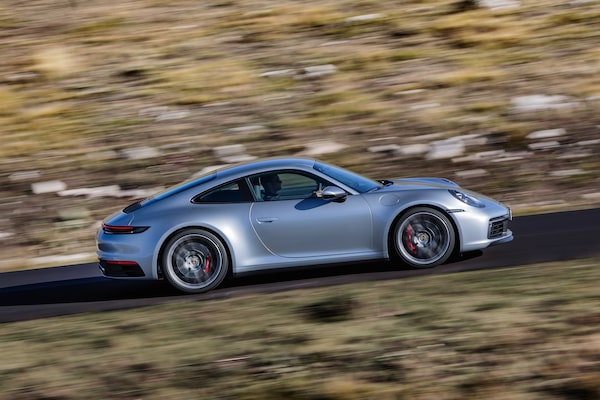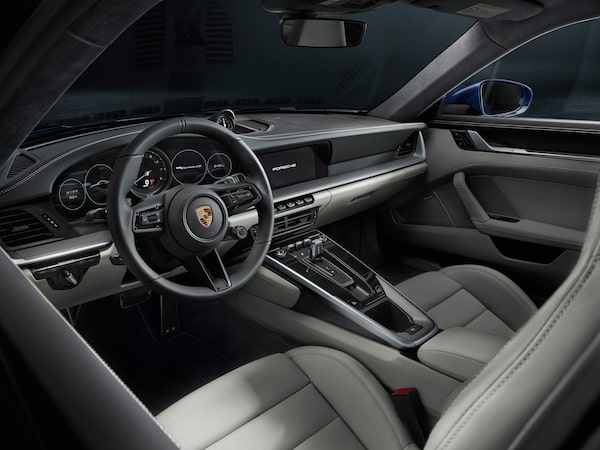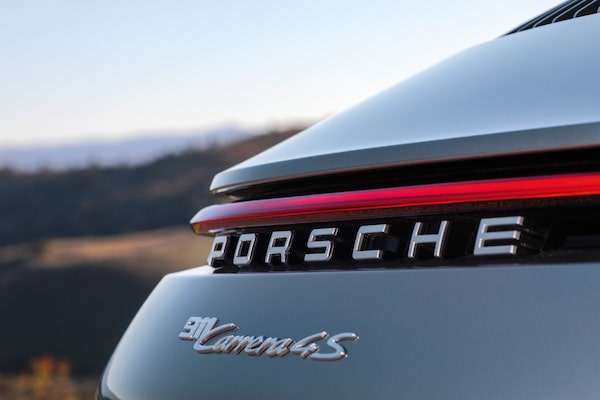
The new Porsche 911 will be a little quicker, a little larger, a little smarter and better equipped.CB/The Associated Press
The eighth generation of the Porsche 911, now 55 years old, was finally revealed in Los Angeles on Tuesday. We won’t see the first of the new 911s, dubbed the Type 992, until next September or October, but when we do, they’ll be a little quicker, a little larger, a little smarter and better equipped.
The first models of the classic sports car to arrive will be the Carrera S and its AWD version, the Carrera 4S, and they’ll be a little more expensive, too: The S will list for $129,100 (up from $120,000), the 4S for $137,400 (up from $127,900). An eight-speed PDK transmission will be standard, with a seven-speed stick shift available later.
Power is up, of course, by 23 hp to 443 hp, thanks to a new fuel-injection process for the flat-six, 3.0-litre engine and a new layout for the turbos, as well as an improved layout for the charge air system. Porsche says zero-to-100-km/h acceleration for the two models is improved to 3.7 seconds and 3.6 seconds respectively, or 0.4 seconds quicker over the line than the current seventh generation. The sport chrono package, currently a $2,380 option, will shave an extra 0.2 seconds from the time.
Everyone will recognize the 911 as being a Porsche, with its fried-egg headlights (now LED) and sloped recess in the hood. The front of the car is 45 millimetres wider, and the rear wheels are now standard at 21 inches. The easiest way to tell the difference is by the single, thin light bar that stretches right across the rear.

The easiest way to tell the difference between the new model and the older ones is by the single, thin light bar that stretches right across the rear.CB

The Porsche 911's power is up by 23 hp to 443 hp, thanks to a new fuel-injection process for the flat-six, 3.0-litre engine and a new layout for the turbos.CB
None of this was a surprise; spy photographers have been taking pictures of the car all year in various states of camouflage. However, this week was the first official confirmation from Porsche of the 911’s details, such as an outer skin entirely made from aluminum, as well as the first chance to see properly inside. A larger 10.9-inch touch screen now sits in the centre of the dash for controlling many of the car’s features.
There’s also a new “wet” mode that uses sensors in the wheel arches to detect water and change the driving dynamics of the car for safer operation.
Is it totally cutting-edge now? No, says interior designer Ivo van Hulten – and that’s intentional.
“We left five buttons exposed (on the dash, for adjusting various vehicle drive functions) and we have the PDK lever as a haptic element, and there’s the analogue rev counter. There are some details that are not necessary to be so classic, but we did this deliberately because we think it evokes a joy of use for every day in a sports car.
“After all, if you touch a touch screen, everything feels the same – you feel nothing. But if you drive this kind of car, it’s important that you get a stimulus from it, being a sports car. Others don’t choose to do this, but we choose to do it.”

A larger 10.9-inch touch screen now sits in the centre of the dash for controlling many of the car’s features.

The first models of the classic sports car to arrive will be the Carrera S and its AWD version, the Carrera 4S.CB
The importance of the 911 cannot be overestimated. In the Canadian market, the 911 comprises 30 per cent of the premium sports car segment, said Marc Ouayoun, CEO of Porsche Canada, and sales this year are up almost 20 per cent compared to last year. About 1,400 of the 8,200 cars and SUVs that Porsche sold last year were 911s, which currently start at $104,000 and rise to more than a quarter-million dollars.
“Canada has been a very good market for sports cars for decades now,” said Ouayoun. “There’s still a very big demand for the 911 in Canada, and I think the transition to the new (Type) 992 will be very smooth.”
Shopping for a new car? Check out the new Globe Drive Build and Price Tool to see the latest discounts, rebates and rates on new cars, trucks and SUVs. Click here to get your price.
Stay on top of all our Drive stories. We have a Drive newsletter covering car reviews, innovative new cars and the ups and downs of everyday driving. Sign up for the weekly Drive newsletter, delivered to your inbox for free. Follow us on Instagram, @globedrive.


